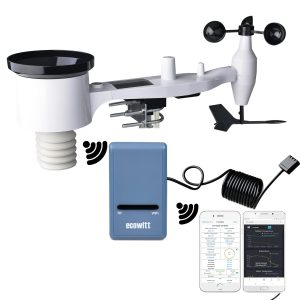What are the Effects of Weather on Amateur Radio propagation? Amateur radio enthusiasts know that weather can significantly impact radio communications. Understanding these effects can help operators optimize their setups and improve their communication experiences. Let’s explore how different weather conditions affect various frequency bands: High Frequency (HF), Very High Frequency (VHF) and Ultra High Frequency (UHF), and Microwave frequencies.
Also be aware that there are other natural phenomena that cause interesting situations on radio. These include Space weather, tectonics and other things too.
High Frequency (HF)
HF bands (3-30 MHz) are known for their ability to support long-distance communication, primarily through ionospheric propagation. Weather conditions can influence HF propagation in several ways:
- Ionospheric Conditions: Solar activity, such as sunspots and solar flares, can enhance or disrupt HF propagation. Increased solar activity generally improves HF propagation by ionizing the upper atmosphere, allowing signals to bounce off the ionosphere and travel long distances.
- Thunderstorms: Lightning from thunderstorms can cause significant static and noise on HF bands, making communication difficult. Operators often need to adjust their frequencies or wait for storms to pass.
- Temperature and Humidity: While not as impactful as solar activity, extreme temperatures and humidity can affect the performance of antennas and other equipment, potentially reducing signal quality.
VHF and UHF
VHF (30-300 MHz) and UHF (300 MHz-3 GHz) bands are typically used for line-of-sight communication, but weather conditions can still play a significant role:
- Tropospheric Ducting: This phenomenon occurs when temperature inversions in the troposphere create ducts that can carry VHF and UHF signals over much greater distances than usual. These conditions are often associated with high-pressure systems and can lead to unexpected long-distance contacts.
- Rain and Fog: Precipitation can absorb and scatter VHF and UHF signals, leading to signal degradation. Heavy rain and fog can particularly impact these frequencies, reducing their effective range.
- Temperature Inversions: Similar to tropospheric ducting, temperature inversions can enhance VHF and UHF propagation by bending signals back towards the Earth’s surface, extending their range.
Microwave Frequencies
Microwave frequencies (above 3 GHz) often referred to as SHF in the amateur radio community, are highly susceptible to weather conditions due to their shorter wavelengths:
If you use or have used a satellite dish to receive television, you will be used to the effects of weather on reception.
- Rain Fade: Rain can significantly attenuate microwave signals, a phenomenon known as rain fade. This is particularly problematic for frequencies above 10 GHz, where heavy rain can cause substantial signal loss.
- Humidity and Water Vapor: High humidity and water vapor can absorb microwave signals, reducing their strength and clarity. This effect is more pronounced at higher frequencies.
- Fog and Snow: Similar to rain, fog and snow can scatter microwave signals, leading to signal degradation. Operators may need to adjust their equipment or frequencies to maintain clear communication during such conditions.
Conclusion
Weather conditions can have a profound impact on amateur radio communications across all frequency bands. By understanding these effects, operators can better prepare for and adapt to changing weather, ensuring more reliable and enjoyable radio experiences.
For more detailed information on how weather affects radio propagation, check out resources like the Radio Society of Great Britain and Ham Shack Reviews.
Stay tuned to MM0ZIF Radio for more insightful articles and updates on amateur radio and weather phenomena!
Tell us how can we improve this post?
Hi I am Marcus, MM0ZIF, a licenced Radio Amateur, Doctor of Musicology, amateur weather enthusiast. I over the years have been a Amateur Radio Tutor, Examiner, and a Regional Manager for the Radio Society of Great Britain.
This site is dedicated more towards Amateur Radio and Weather, with an angle on Technology too. I also maintain https://havenswell.com/ which is my other blog which is more aimed at cooking, hobbies and life in general as well as businness and networking.










